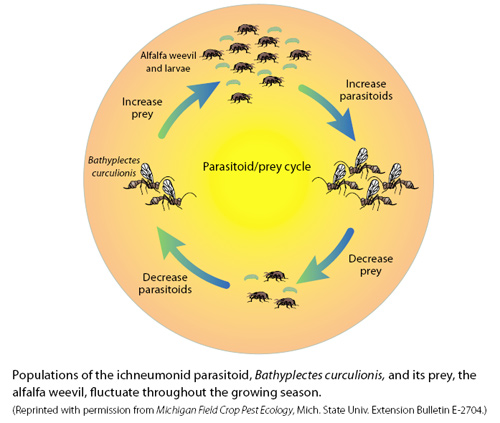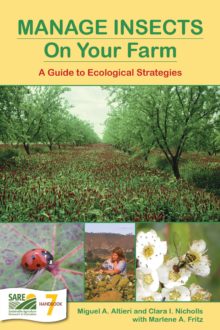Principal Parasitoids
Dipteran flies. Entomologists have described more than 18,000 species of dipteran, or fly, parasites, which have diversified over an expansive range of hosts (Table 5). Unlike parasitic wasps, most species of parasitic flies lack a hardened structure with which to deposit eggs inside their hosts. Instead, they lay their eggs or larvae on plants, where the parasitoid larvae can easily penetrate the host but also where their target victims can eat them.
Individual species of parasitic flies are extraordinarily capable of surviving on many kinds of foods. The tachinid Compsilura concinnata, for example, has been successfully reared from more than 100 host species and three different host orders. Members of other Diptera families — such as big-headed flies in the Pipunculidae family, which are endoparasites of leafhoppers and planthoppers, and the small-headed Acroceridae, which only target spiders — are generally more specialized. However, some attack hosts from several families or subfamilies.
Chalcid wasps. For both natural and applied biological control, the chalcid wasps of the superfamily Chalcidoidea are among North America’s most important insect groups. About 20 families and 2,000-plus species have been found on the continent — among the smallest of insects.
Because they are so diminutive, chalcid wasps are often underestimated in their numbers and effectiveness. They can be seen tapping leaf surfaces with their antennae in search of their host’s “scent,” but their presence is most commonly revealed by the sickly or dead hosts they leave in their wake. They parasitize a great number of pests, and different species attack different stages of the same host.

The following six families have proven especially useful in managing pests.
Fairyflies (Mymaridae). At between 0.008 and 0.04 inches (0.2–1 mm) long, these smallest of the world’s insects can fly through the eye of a needle. Viewed under the microscope, the back wings of fairyflies contain distinctive long hairs.
Fairyflies parasitize the eggs of other insects — commonly flies, beetles, booklice and leafhoppers. Many fairyfly species, especially those belonging to the genus Anaphes, play crucial roles in biological control. The introduced egg parasite A. flavipes, for example, is one of two parasites that have been established for cereal leaf beetle management in small grains. In pesticide-free California vineyards with ground vegetation, the tiny Anagrus epos wasp can make a big dent in grape leafhopper densities.
Trichogramma wasps (Trichogrammatidae). Trichogramma wasps are the most widely released natural enemies. The tiny female wasp — generally less than 0.04 inch (1 mm) long — lays an egg inside a recently laid host egg, which blackens as the larva develops.
The host range of many Trichogramma wasps spans numerous species and families of insects. Moths, butterflies, beetles, flies, wasps and true bugs are all frequent victims. Some Trichogramma wasps even use their wings in a rowing motion to reach aquatic hosts.
Among commercially available species in the U.S. are T. minutum, T. platneri and T. pretiosum, which are released into fields on cards loaded with the parasitized eggs of non-pest hosts. Some foreign species — including T. ostriniae, T. nubilale and T. brassicae — also are being evaluated for augmentation biocontrol against European corn borers.
Eulophid wasps (Eulophidae). Eulophid wasps number more than 600 in North America, making theirs one of the largest chalcid families. About 0.04 to 0.12 inches (1–3 mm) long, they are often brilliant metallic blue or green.
Some species of eulophids are mite predators while others attack spider egg cases, scale insects and thrips. Most eulophids, however, parasitize flies, other wasps or the larvae or pupae of beetles or moths. Leaf-mining and wood-boring insects are frequent hosts.
Eulophids destroy many major crop pests. In the Midwest alone, Sympiesis marylandensis is an important parasite of spotted tentiform leafminer in apples. Diglyphus isaea — available commercially — is a primary parasite of agromyzid leafminers in greenhouses. Edovum puttleri attacks the eggs of Colorado potato beetles. Finally, Pediobius foveolatus — introduced from India and also available commercially — parasitizes Mexican bean beetle larvae.
Pteromalid wasps (Pteromalidae). This large family of wasps assaults many types of insects, including the larvae of moths, flies, beetles and wasps. Several pteromalids target scale insects and mealybugs and some even act as “hyperparasitoids” — parasitizing other parasites within their hosts.
In the upper Midwest, Pteromalus puparum is a key enemy of imported cabbageworm pupae, each of which can involuntarily host more than 200 Pteromalus offspring. Anisopteromalus calandrae, which attacks the larvae of beetles that infest stored grain, impressed scientists several decades ago with its ability to suppress 96 percent of rice weevils in wheat spillage in small rooms. A. calandrae can now be purchased for release in grain storage and handling facilities.
Encyrtid wasps (Encyrtidae). Responsible for much of the classical biological control of scale insects and mealybugs in fruit trees, this important family of natural enemies encompasses about 400 species in the U.S. and Canada. Its extensive host range includes soft scales, armored scales, mealybugs and the eggs or larvae of insects in about 15 families of beetles, 10 families of flies and 20 families of moths and butterflies.
Several commercially available encyrtids now help manage scale and mealybugs in greenhouses: Leptomastix dactylopii, for example, parasitizes citrus mealybug, while Metaphycus helvolus attacks black, hemispherical, nigra, citricola, brown soft and other soft scales.
Other noteworthy encyrtids include Ooencyrtus kuwanae, an introduced parasite of gypsy moth eggs, and Copidosoma floridanum, a native parasite of cabbage looper larvae.
Aphelinid wasps (Aphelinidae). The effectiveness of aphelinids in managing scale insects has earned them one of the best reputations in biological control. They also destroy mealybugs, whiteflies, aphids and other families of Homoptera.
Aphelinus varipes parasitizes greenbugs, A. mali targets the woolly apple aphid, and members of the genus Eretmocerus attack silverleaf whitefly. Encarsia formosa, in commercial use since the 1920s, is now released into greenhouses worldwide; it kills almost 100 greenhouse whitefly nymphs during its 12-day life span.
